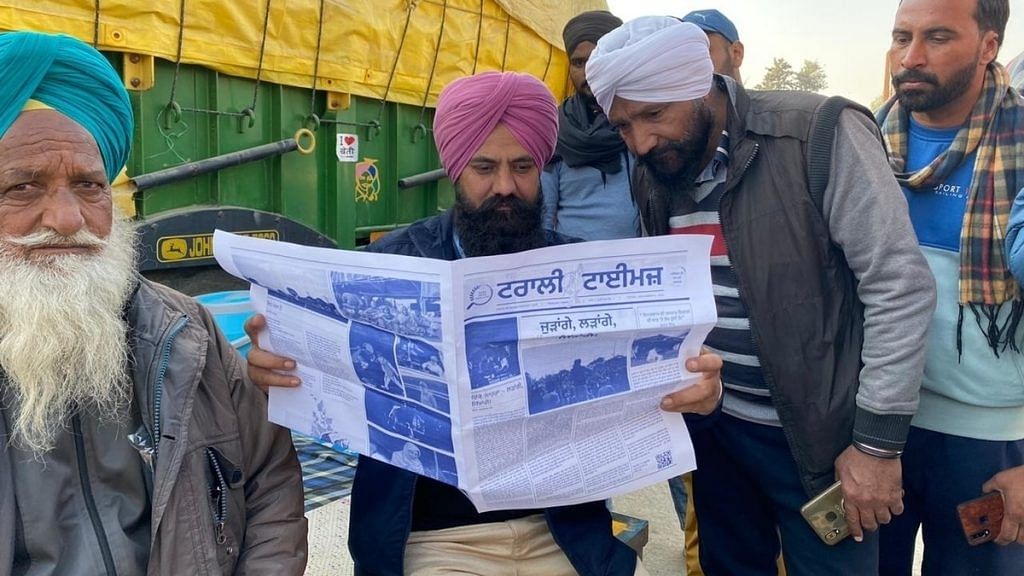New Delhi: On Friday morning, as the ongoing farmers’ protest entered its 23rd day, those stationed at the Singhu and Tikri borders of the national capital woke up to the first-ever issue of a bi-weekly newsletter, exclusively by and for the protesters.
“Inquilaab di talwar vichaaran di saan tey tez hondi ae (the sword of revolution is sharpened at the whetstone of ideas, a quote by Bhagat Singh),” read one of the lead headlines of the bilingual newsletter that has been named Trolley Times.
Born out of a late night conversation four days ago among some artists on a tractor-trolley at Singhu, it aims to touch every single corner of the kilometres-long agitation at Delhi’s borders and ensure that the message from the stage, latest developments in talks with the government and other such reports are easily accessible to the agitating farmers.
The first edition of the Trolley Times has three long-form articles and features in Gurmukhi, and photos, illustrations and a Hindi section for agitators from states other than Punjab.
“We reached here on 26 November and soon after the national media began calling us terrorists or Khalistani. But we are not those people at all. We are very attached with how to make this a peaceful protest,” Narinder Singh Bhinder, a theatre artiste from Patiala on board whose trolley this idea came to life, told ThePrint.
Protests at Delhi’s borders have only intensified in the weeks since 26 November seeking a repeal of the three central farm laws introduced earlier this year. With an estimated 3 lakh people now on both Singhu and Tikri borders, Bhinder believes it is getting harder to make sure everyone is apprised of the situation.
“While there is a huge crowd in front of the stage where discussion and conversations take place, there are many who don’t always turn up there and thus may miss out on some information. As it is, the national media hasn’t been portraying us well,” Bhinder said.
The first edition of Trolley Times was printed in Gurgaon at a cost of around Rs 12,000. Nearly 2,000 copies were printed, with 1,200 meant for the Singhu border and 800 for Tikri.
Also read: Middlemen in Indian agriculture help reduce farmers’ risks that govt doesn’t: Study
How first edition of Trolley Times was created
Using social media and WhatsApp to spread the word and garner content for the bi-weekly newsletter, the proposal for the newsletter received “overwhelmingly positive” response.
“We got some 300-400 emails and even more content on WhatsApp. We reviewed a lot of poetry, songs and short stories on how people are involved in this movement,” Gurdeep Dhaliwal, a documentary photographer and writer who is part of the newsletter team, told ThePrint. “The final page even has an illustration from a Kolkata-based designer.”
The four pages include content not just in Gurmukhi, but also in Hindi.
“We have kept it bilingual so narratives from Ghazipur and Shahjahanpur can also be included. There is one article about the farm laws by AIKM (All India Kisan Mahasabha) leader, Purushottam Sharma, there is one student perspective as well by former JNU president Geeta Kumari who is from Haryana and a piece from a young activist from Jaipur, Rahul, on how farmers from states like Rajasthan, Haryana and Gujarat have mobilised,” said Navkiran Natt, student youth activist and film scholar who handled the Hindi translation in the newsletter.
As swiftly as the team collected content for the paper, a masthead design was also created and shared.
“I reached out to two artists in Delhi, Thukral and Tagra, who said they will design the masthead of the newsletter for free. Within two hours, they sent me an editable file, so I just adjusted all the content into it,” Dhaliwal said.
While the team couldn’t get an input from the Ghazipur border protest site, Natt said their aim for the next edition is to include everyone.
With dark blue text and off-white paper, the first edition of Trolley Times was printed Thursday morning and reached Singhu and Tikri borders late in the night. It was distributed among protesting farmers Friday morning.
“It cost us Rs 12,000 to print 2,000 copies. It was entirely community funded. We got it done in Delhi and were sure about using good quality paper,” Dhaliwal said.
“Judaange, Ladaange, Jeetange! (United, we will fight and win)” reads Trolley Times’ front-page headline in Gurmukhi. As the protest continues amid deadlock with the Centre, Dhaliwal and Bhinder believe this newsletter will quell the lack of faith farmers have in mainstream media.
Also read: New farm laws were long overdue, haven’t come overnight, says PM Modi
